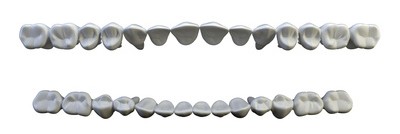BioCompatible Crowns
A dental crown restores a tooth that’s decayed, cracked, or badly chipped. As a biological dentist, Dr. Taylor is concerned with the materials we place in your mouth. Dr. Taylor favors non-metal restorations.
All Porcelain Crown
Dr. Taylor considers all-porcelain (or ceramic) crowns the most biocompatible, unless a patient’s materials compatibility testing says otherwise. Porcelain is in the same family of materials as glass, china, pyrex, and pottery. The advantages to all-porcelain restorations are biocompatibility and esthetics. The disadvantages are that all-porcelain crowns require more “bulk” for strength, so more tooth may be sacrificed. If this required thickness isn’t maintained, ceramic can break because of its inherent brittleness.
Some patients have concerns with the chemical components of porcelain. Porcelain is made of metallic and non-metallic elements that have been fused together in high heat. After fusing, these metallic components don’t act like metals anymore. This nonreactivity is the reason you can store strong acids and strong bases in glass containers. Dr. Taylor favors porcelain as the most biocompatible restorative material.
Biomimetics plays a crucial role in cases where a crown is being used to restore a cracked tooth. Dr. Taylor can have the crowns made of newer, strong ceramic so patients won’t have metal in their mouth.
Same Day Crown Procedure
Dr. Taylor uses the modern technology of CEREC to create your custom E-Max crown here in our office — so at the end of your procedure your walk out the door with your newly restored tooth.
Procedure Overview:
Dr. Taylor begins your treatment by taking digital CEREC images of your existing tooth to retain the size and contour of your original tooth. Then, the tooth is numbed and the decayed or compromised tooth structure is removed, conserving as much natural tooth structure as possible. Dr. Taylor shapes the tooth for the new crown and takes a few more digital images of the remaining tooth. It takes about 1 hour for the CEREC unit to mill and fire in a ceramic oven, in which time you can relax in the treatment room or take a walk around downtown Morro Bay. When you return the fit and appearance of the crown are checked for function and quality and then bonded to the tooth.
If you are interested in a Zirconia porcelain/ceramic crown, the treatment requires appointments on different days. After the first visit you will leave with a temporary crown while a dental lab makes your Zirconia crown. The second visit is approximately 2 weeks later when the final restoration will be permanently cemented.
Crowns can be made in different ways and of many different materials.
All-metal Crown
The material in an all-metal crown in crowns is categorized according to its potential reactivity with the body: High noble (least reactive), noble, and base metal (most reactive).
A high-noble metal or “gold” crown is the most durable material. If you’ve ever seen a “gold tooth,” it was probably a gold crown or onlay. Beware though: there are many many alloys available even in this broad category. A “gold-colored” crown doesn’t necessarily mean it’s mostly gold or high-noble. Crowns with a lower percentage of gold can be tinted with other metals (like copper) to “look gold.” In fact, Dr. Taylor has had patients who have tested as reactive to copper, and that copper has been traced to their very gold-looking crowns. A more-noble mix of gold/platinum or gold/palladium can look nearly “silvery.” These crowns are the most durable because they can be so well adapted to the tooth and because they’re so strong. Assuming the crown fits well, the gap where the crown meets the tooth (or the margin) accumulates less plaque and can be maintained well with regular home care.
Porcelain Fused to Metal Crown (PFM)
Many dentists today place “PFMs” or porcelain-fused-to-metal crowns. The porcelain gives the crown a more-natural appearance while the metal underneath gives it more strength. The metal is these crowns is categorized in the same way as all-metal crowns: high-noble, noble, and base metal. These names refer to the degree of reactivity the metal can potentially have with the body. Base metal PFMs often contain nickel, beryllium, or chrome cobalt. High noble PFMs contain a majority of gold, with some other palladium, platinum, silver, or other elements. Again though, they can contain less-desirable metals. PFMs combine the desirable strength of metal with the coloring of porcelain. If the margin is all metal, PFMs can also adapt very well to the tooth.





